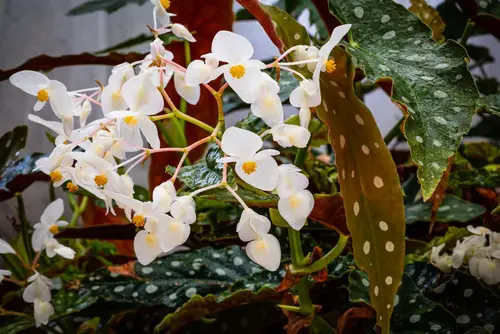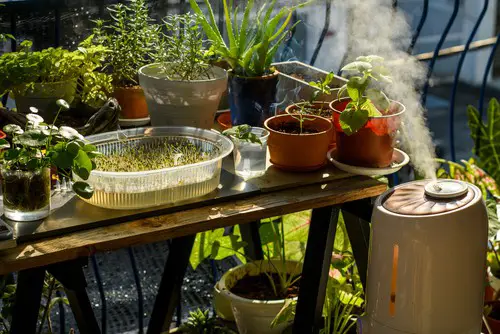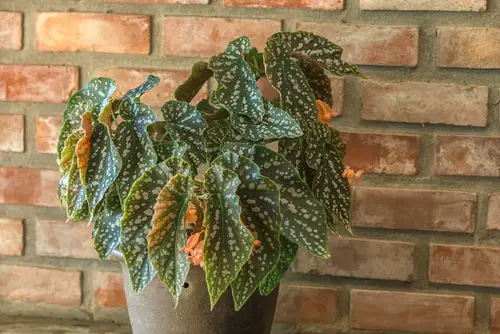Begonias are popular houseplants known for their stunning foliage and bright flowers. However, if you notice that your begonia leaves are turning brown, it could be a sign of an underlying problem.
Begonias Turning Brown can be caused by a variety of factors, including watering issues, pests, and disease. Therefore, it’s important to understand the causes and symptoms of brown leaves on begonias to prevent further damage to your plants.
To understand why your begonia leaves are turning brown, it’s essential to know more about the plant’s care requirements. Begonias require a specific amount of light, water, and humidity to thrive. Overwatering or underwatering can cause brown leaves, while low humidity levels can lead to dry, crispy foliage.
Additionally, too much direct sunlight can scorch the leaves, causing brown patches or spots. Therefore, it’s crucial to provide your begonia with the proper care to keep it healthy and prevent brown leaves.
If you’re experiencing brown leaves on your begonia, don’t panic. By identifying the underlying cause and taking appropriate action, you can restore your plant’s health and beauty. With the right care, your begonia can continue to thrive and bring joy to your home.
Key Takeaways
- Brown leaves on begonias can be caused by a variety of factors, including watering issues, pests, and disease.
- Proper care is essential to prevent brown leaves on begonias, including providing the right amount of light, water, and humidity.
- By identifying the underlying cause of brown leaves and taking appropriate action, you can restore your begonia’s health and beauty.
Don’t miss out on these other top picks:
- Why Are My Basil Stems Turning Brown?
- Why Are My African Violet Leaves Turning Brown?
- Why Are My Zinnia Leaves Turning Brown?
Understanding Begonias

Begonias are a popular houseplant that come in a variety of species and varieties. They are known for their attractive foliage and beautiful flowers. Begonias belong to the Begoniaceae family and are native to tropical and subtropical regions of the world.
Some of the most common types of begonias include:
- Begonia semperflorens: also known as wax begonias, they are known for their waxy leaves and colorful flowers.
- Rex begonias: known for their unique and colorful foliage, rex begonias are a popular choice for indoor gardens.
- Rhizomatous begonias: these begonias grow from rhizomes and are known for their unique foliage and flowers.
- Cane begonias: these begonias have tall, bamboo-like stems and are known for their large, showy flowers.
- Tuberous begonias: these begonias have large, tuberous roots and are known for their colorful flowers.
Begonias have different requirements when it comes to light, water, and soil. Some prefer bright, indirect light, while others can tolerate more direct sunlight. Similarly, some varieties prefer moist soil, while others prefer drier conditions.
One thing to keep in mind when caring for begonias is that they are susceptible to root rot, so it’s important not to overwater them. It’s also important to provide adequate drainage to prevent water from pooling around the roots.
Begonia Care Requirements
Begonias are beautiful plants that require proper care to thrive. Here are some of the care requirements for begonias:
1. Watering Needs
Begonias require regular watering to maintain their growth and health. Overwatering can lead to root rot, while underwatering can cause the leaves to turn brown and crispy. It is essential to keep the soil moist but not soggy.
The best way to determine if the plant needs water is to check the soil’s moisture level. If the soil feels dry to the touch, it is time to water the plant.
2. Sunlight Requirements
Begonias prefer indirect sunlight. Direct sunlight can scorch the leaves and flowers, causing the edges to turn brown. To prevent this, it is best to place the plant in a location that receives bright, indirect sunlight. If the plant is grown indoors, it is best to place it near a window that receives bright, indirect sunlight.
3. Temperature and Humidity Preferences
Begonias prefer warm temperatures between 60°F and 75°F. They also prefer high humidity levels, and low humidity can cause the leaves to turn brown and crispy. To maintain the proper humidity level, it is best to mist the plant regularly. You can also place a tray of water near the plant to increase the humidity level.
4. Fertilizer Requirements
Begonias require regular fertilization to maintain their growth and health. It is best to fertilize the plant every two weeks during the growing season.
The best fertilizer for begonias is a balanced fertilizer with equal amounts of nitrogen, phosphorus, and potassium. It is essential to follow the instructions on the fertilizer package to avoid over-fertilization, which can damage the plant.
Begonias Turning Brown – 2 Common Problems

Begonias are relatively easy to care for, but they can still suffer from a variety of problems. Here are some of the most common issues that can cause begonia leaves to turn brown:
Diseases
Begonias can be susceptible to a range of fungal and bacterial diseases, including bacterial leaf spot, powdery mildew, and botrytis blight. These diseases can cause brown spots or patches on the leaves, as well as leaf drop and stem rot.
To prevent these diseases, it’s important to keep the plant healthy by not overwatering, providing good air circulation, and avoiding getting the leaves wet when watering. If you notice signs of disease, remove infected plant material and treat with a fungicide or bactericide as directed.
Pests
Begonias can also be attacked by a variety of pests, including mites, aphids, and mealybugs. These pests can cause damage to the leaves, which can turn brown and drop off.
To prevent pest infestations, keep the plant healthy and clean, and regularly inspect the leaves for signs of pests. If you see signs of infestation, treat with an appropriate insecticide or use natural methods like neem oil or insecticidal soap.
Overall, the key to preventing common problems in begonias is to provide the plant with the right growing conditions and to keep a close eye on it for signs of trouble. With proper care, your begonia should thrive and remain healthy for years to come.
Symptoms and Causes of Brown Leaves
Begonia plants are known for their beautiful foliage, but when the leaves start turning brown, it can be a sign that something is wrong. Brown leaves can be caused by a variety of factors, including overwatering, sunburn, low humidity, disease, and pest infestation.
1. Overwatering
Overwatering is one of the most common causes of brown leaves on begonia plants. When the soil is constantly wet, the roots can become waterlogged, which can lead to stunted growth and brown spots on the leaves.
To prevent overwatering, it is important to allow the soil to dry out between waterings and to make sure that the pot has proper drainage.
2. Sunburn
Begonia plants are sensitive to direct sunlight, and too much sun exposure can cause brown spots and discoloration on the leaves. This is because the intense heat and light can damage the photosynthetic process, which can lead to the browning of begonia leaves.
To prevent sunburn, it is recommended to keep the plant in a spot that receives bright, indirect light.
3. Low Humidity

Begonia plants prefer high humidity, and when the air is too dry, the leaves can become brown and crispy. This is because low humidity can cause the plant to lose moisture through its leaves, which can lead to wilting and discoloration. To increase humidity, it is recommended to mist the leaves with water or to place a humidifier near the plant.
4. Disease and Pest Infestation
Begonia plants can be susceptible to a variety of diseases and pests, which can cause the leaves to turn brown and yellow. Common pests include spider mites, mealybugs, and thrips, while common diseases include powdery mildew and bacterial leaf spot.
To prevent disease and pest infestation, it is recommended to keep the plant in a well-ventilated area and to regularly inspect the leaves for signs of damage.
Preventing and Treating Brown Leaves
Begonias are cherished houseplants known for their stunning foliage and bright blooms. However, it can be alarming when the vibrant green leaves take on a brown hue. Fortunately, there are several steps that can be taken to prevent and treat brown leaves.
1. Proper Watering
The most common cause of brown leaves is underwatering. In other words, the begonia is thirsty! Begonias constantly need the right amount of moisture. The soil shouldn’t be soggy or overwatered, but it shouldn’t be dry either.
To avoid overwatering, make sure the soil is moist but not wet. To avoid underwatering, water the plant when the top inch of soil feels dry to the touch. It’s important to note that different cultivars may have different watering needs.
2. Adequate Sunlight Exposure
Begonias need adequate sunlight exposure to thrive, but too much direct sunlight can cause brown spots on the leaves. Make sure the plant is not exposed to excessive direct sunlight, which can dramatically increase water loss. A good rule of thumb is to place the plant in a location that receives bright, indirect sunlight for at least six hours a day.
3. Maintaining Humidity
Begonias prefer high humidity levels, so it’s important to maintain a humid environment around the plant. This can be achieved by placing a tray of water near the plant or by misting the leaves regularly. However, be careful not to overdo it, as excessive moisture can lead to fungal diseases.
4. Disease and Pest Control
Brown spots on begonia leaves can also be caused by pests or diseases. If the plant is infected with pests such as spider mites or mealybugs, it’s important to treat the plant with an appropriate insecticide.
If the plant has a disease such as bacterial leaf spot or botrytis blight, it’s important to remove the infected leaves and treat the plant with a fungicide. It’s also important to avoid overcrowding the plant, as this can create a favorable environment for pests and diseases.
Additional Tips for Healthy Begonias

In addition to addressing the causes of brown leaves, there are several things you can do to promote healthy growth and blooming in your begonias.
1. Soil
Begonias prefer well-draining soil that is rich in organic matter. A good potting mix for indoor plants is a mix of peat moss, perlite, and vermiculite. If planting in the ground, amend the soil with compost or well-rotted manure.
2. Watering
Begonias need consistent moisture, but not to the point of being waterlogged. Water when the top inch of soil feels dry to the touch. Avoid getting water on the leaves to prevent bacterial and fungal diseases.
3. Fertilizer
Begonias benefit from regular fertilization during the growing season. Use a balanced fertilizer every two to four weeks. Avoid fertilizing during the winter months when growth slows down.
4. Light
Begonias thrive in bright, indirect light. Too much direct sunlight can scorch the leaves, while too little light can cause leggy growth and few blooms. Red-flowered begonias, in particular, need bright light to develop their vibrant color.
5. Humidity
Begonias prefer high humidity levels, especially tropical varieties. To increase humidity, place a tray of water near the plant or use a humidifier. Alternatively, group plants together to create a microclimate of higher humidity.
6. Pruning
Regular pruning can help keep your begonia bushy and compact. Pinch back the tips of stems to encourage branching and remove any dead or yellowing leaves. Prune after the plant has finished blooming.
Frequently Asked Questions

What causes brown spots on begonia leaves?
Brown spots on begonia leaves are usually caused by fungal or bacterial infections. These infections can be caused by overwatering, poor air circulation, or high humidity. To prevent brown spots, make sure to water your begonias properly, avoid overcrowding them, and provide adequate ventilation.
Why are my begonia flowers turning brown?
Begonia flowers can turn brown due to a variety of reasons, including overwatering, underwatering, high temperatures, low humidity, or pests. To prevent this, make sure to water your begonias properly, provide adequate humidity, and protect them from pests.
How do I prevent my begonia leaves from turning brown on the edges?
Begonia leaves can turn brown on the edges due to underwatering, low humidity, or pests. To prevent this, make sure to water your begonias properly, provide adequate humidity, and protect them from pests.
What are common problems with wax begonia leaves?
Common problems with wax begonia leaves include yellowing, browning, or spotting. These issues can be caused by overwatering, underwatering, poor soil drainage, or pests. To prevent these problems, make sure to water your wax begonias properly, provide good soil drainage, and protect them from pests.
What should I do if my begonia leaves turn red?
If your begonia leaves turn red, it could be a sign of stress due to too much sunlight, too little water, or poor soil drainage. To remedy this, move your begonia to a shadier spot, water it properly, and improve soil drainage.
How can I rejuvenate my begonias?
To rejuvenate your begonias, prune off any dead or damaged leaves, water them properly, and fertilize them regularly. You can also repot them in fresh soil and provide adequate light and humidity.

Hey, I’m Lisa and I’ve been an avid gardener for over 30 years. I love writing, talking and living in the garden! Feel free to connect with me on my socials below


